The Unwrap UVW modifier lets you assign mapping (texture) coordinates to objects and sub-object selections, and to edit those coordinates by hand as well as with a variety of tools. You can also use it to unwrap and edit existing UVW coordinates on an object. You can adjust mapping to fit on Mesh, Patch, Polygon, HSDS, and NURBS models using any combination of manual and several different procedural methods.
You can use Unwrap UVW as a self-contained UVW mapping tool and texture-coordinate editor, or in conjunction with the UVW Map modifier. In the latter case, you usually do so in order to use a mapping method unavailable in Unwrap UVW, such as Shrink Wrap. You can animate UVW coordinates by turning on the Auto Key button and transforming the coordinates at different frames.
In using Unwrap UVW, you usually break up the object's texture coordinates into smaller groups known as clusters. That way you can position the clusters precisely over different areas of the underlying texture map for optimal mapping accuracy. Each of these clusters has an outline called a map seam which appears superimposed over the object in the viewports. This helps you visualize the locations of mapping clusters on the object surface. You can toggle this feature and set the line thickness with the Display settings.
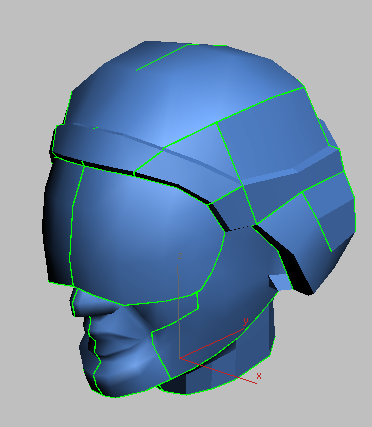
Open UVW map seams shown on head model in viewport
 Unwrap UVW Modifier Improvements
Unwrap UVW Modifier Improvements
In Autodesk 3ds Max 2012, the Unwrap UVW modifier has been improved significantly to provide an optimized workflow and new features. The modifier rollouts on the Modify panel now include icons for faster comprehension, and the editor contains new rollouts with a large number of tools that were previously available only from menus, plus upgraded toolbars. The new rollouts include tools for flattening texture coordinates and packing and stitching UV clusters. Among the new tools are several for aligning texture coordinates, and, most significant, the Peel toolset for easy, intuitive unwrapping of complex models.
Even if you're familiar with the Unwrap UVW modifier, it is highly recommended that you review this topic carefully, as well as the following topics:
Self-Contained Mapper and UVW Coordinate Editor
Rather than creating a large modifier stack by first making a sub-object selection of faces and then adding a UVW Map modifier to specify the type of mapping, you can use the Unwrap UVW modifier to do both. You can select sub-object vertices, edges, or faces/patches, store sub-object selections as named selections, map them using planar and other methods, and then edit the UVW coordinates for each sub-object selection, all from within the Unwrap UVW modifier. For example, to map a character's face using three planar maps, you could create three sub-object selections of the front and sides of the face, planar-map the selections individually, and then edit the UVW coordinates for each selection, all without leaving the Unwrap UVW modifier.
Support for Multiple Unwrap Objects
Instancing capabilities in Unwrap UVW make it easy to apply texture coordinates across several objects. First select the objects, then apply Unwrap UVW. When you open the editor, you’ll see the mapping coordinates for all selected objects containing the instanced modifier. The editor shows each object’s wireframe color to help you see which set of coordinates belong to each object.
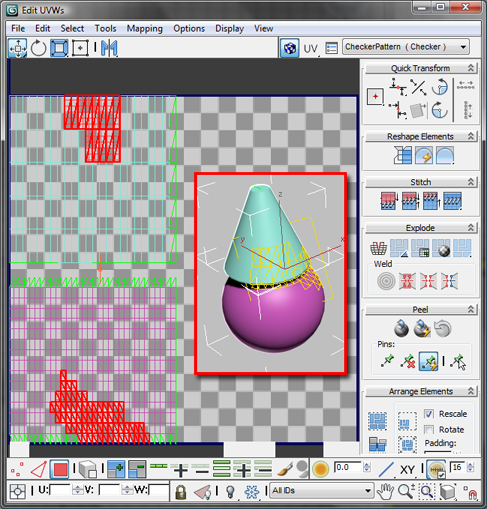
Left: Two objects’ UVW coordinates in the editor, showing wireframe colors.
Right (inset): The objects with a shared Unwrap UVW modifier in the viewport.
What Happens to Existing UVW Coordinates
When you apply the Unwrap UVW modifier, it stores the object's current mapping coordinates in the modifier. If the object has no mapping coordinates, the modifier creates new ones by applying planar mapping. If the incoming data on the stack is a face-level or polygon-level sub-object selection, then only the UVWs for the selected polygons are brought into the modifier.
When the modifier is evaluated, its UVWs are reassigned to the object flowing down the pipeline. So if the UVWs upstream are changed, the changes won't make it past the Unwrap UVW modifier. If the Unwrap modifier is operating on a selection of polygons, then upstream changes to unselected polygons will still be able to flow past the Unwrap modifier.
Native Support for HSDS, Polygon Object, and Patch mapping
Unwrap UVW supports polygon faces and Bezier quad and tri patch faces in addition to triangles and quads.
Below is a sample of what the various face types look like based on the incoming type. For HSDS and Poly surfaces, the basic interface remains the same, except that the maximum number of sides per polygon increases from 4 to over two billion. HSDS supports only one level of detail: the level at which the mapping was. Patches have handles on nonlinear vertices. These handles work just like regular patch handles.
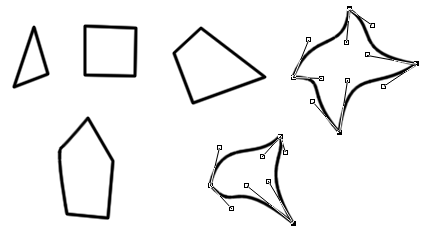
Polygons and faces from HSDS and Poly surfaces; handles appear for nonlinear vertices
Although not its primary purpose, you can use the Unwrap UVW modifier to freeze UVWs. You can apply mapping after an animated deformation and have the mapping stick to the object. For example, you can apply Unwrap UVW above a Morpher modifier in the modifier stack, apply planar maps and edit the UVW coordinates. The mapping will follow the morphing geometry.
To perform quick planar mapping:
You'll find the Quick Planar Map controls on the Edit UVs rollout of the Unwrap UVW modifier.
 (Display Quick Planar Map) is on.
(Display Quick Planar Map) is on.
The Quick Planar Map gizmo appears juxtaposed over the face selection, showing the default Averaged Normals mapping. Even though the X button displays by default, Averaged Normals is the default setting.
 (Quick Planar Map). To map additional faces, proceed from step 3.
(Quick Planar Map). To map additional faces, proceed from step 3.
To use Unwrap UVW with the standard mapping methods:
This procedure offers a general overview of using the basic Unwrap UVW tools available on the Modify panel and the Edit UVWs dialog. Unwrap UVW provides many additional tools not described in this procedure, particularly in the editor.
For procedures detailing other mapping methods available with Unwrap UVW, see To use Peel Mode, To use Pelt mapping and To use Spline mapping.
Within the single modifier, you can apply as many different mappings as you like to different polygon selections.
Each time you adjust the mapping gizmo, the texture display in the viewports updates to reflect the mapping changes.
You can also open the editor (Edit UVs rollout  Open UV Editor) to view the changes in the generated texture coordinates as you adjust the gizmo.
Open UV Editor) to view the changes in the generated texture coordinates as you adjust the gizmo.
 Display Group
Display Group  Map Seams is on.
Map Seams is on.
 Open UV Editor).
Open UV Editor).
By default, the editor displays a checkered background. To view the map in the material on the object, you need to change a setting.
The map appears as the background.
By default, all the UVW clusters display. To work on one cluster at a time, you need to filter the UVWs.
 lower toolbar, click
lower toolbar, click  (Display Only Selected Faces).
(Display Only Selected Faces).
At this point, the editor shows only polygons you select in the viewport, and hides the rest. You can select polygons to show directly in the viewport, or choose a named selection set. In the next step, you'll use the latter method.
The viewports show the selection as active, and the UVW coordinates for the selection appear in Edit UVWs window.
 select and move one or more UVW polygons.
select and move one or more UVW polygons.
In the viewports, the texture slides around the selected portion of the object mesh.
The polygons' UVW coordinates display in the Edit UVWs window. This is another way of choosing what you want to work on.
As you can see, from within the Unwrap UVW modifier you can assign multiple mapping types to different, optionally named polygon selections, and then edit the UVW coordinates to fine-tune map placement on the geometry.
To export texture coordinates to a paint program:
Once you've laid out an object's texture coordinates in the Unwrap UVW modifier editor, you can use this feature to export them to a paint program for creating the texture map.
 Render UVW Template.
Render UVW Template.
This opens the Render UVs dialog:
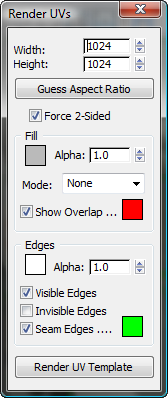
This opens a new rendered frame window containing the rendered template as a bitmap. Inspect the output, and if changes are necessary, make them on the Render UVs dialog and re-render.
 (Save Bitmap), and then use the file dialog to specify the file type and name. Click Save to export the file.
(Save Bitmap), and then use the file dialog to specify the file type and name. Click Save to export the file.
If you want to use the rendered transparency information in the paint program, be sure to save in a format that supports the alpha channel, such as TIF or Targa.
Be sure to paint over or erase all the edges so they don't appear in the final texture.
The painted texture map follows the outlines set up by the exported UVs.
The Peel toolset, new in Autodesk 3ds Max 2012, provides an implementation of the LSCM (Least Square Conformal Maps) method of unwrapping texture coordinates, for an easy and inutuitive workflow in flattening complex surfaces. This procedure shows some of the basic methods available with the Peel tools used on a simple character model. The idea is to give you a rough idea of how to use them in your own projects with more-complex objects such as character meshes.
After opening the file, you might want to select all the bones in the scene and delete them. Also, delete the Skin modifier, apply a new, blank material, apply a UVW Map modifier, and collapse the stack (or use some other method of resetting the UVs).
 ) using the additional tools available at that level, such as
) using the additional tools available at that level, such as  (Loop). You can then make seams out of the edge selection with
(Loop). You can then make seams out of the edge selection with  (Convert Edge Selection To Seams).
(Convert Edge Selection To Seams).
The following illustration shows seams created for the arm and hand.
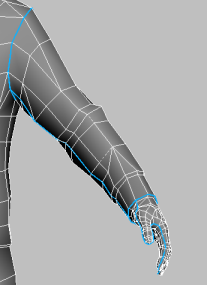
Typically you'd create seams for the entire character mesh before proceeding.
 (Polygon) sub-object level and select a polygon on the arm.
(Polygon) sub-object level and select a polygon on the arm.
 (Expand Face Selection to Seams).
(Expand Face Selection to Seams).
This selects all polygons on the arm enclosed by the seams.
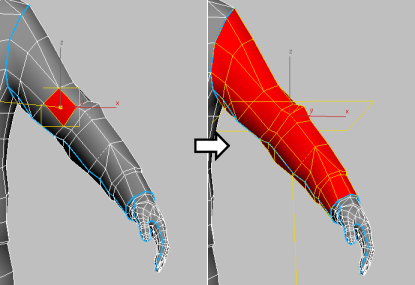
 (Peel Mode).
(Peel Mode).
The Edit UVWs dialog opens with the arm cluster flattened and ready to work with in Peel Mode, along with other, non-flattened clusters, such as the hand at bottom-left. (Note: Your results might differ, and probably will.)
This demonstrates that, if the Polygon sub-object level is active and any polygons are selected when you activate Peel Mode, only those polygons are peeled. You'll demonstrate this further in the next step.

 to access the Vertex sub-object level, make sure no vertices are selected, and then drag a vertex in an non-peeled cluster
such as the hand. Then drag a vertex in the peeled cluster.
to access the Vertex sub-object level, make sure no vertices are selected, and then drag a vertex in an non-peeled cluster
such as the hand. Then drag a vertex in the peeled cluster.
To see this, play the following video:
As you can see, dragging a vertex in a non-peeled cluster moves only that vertex, whereas dragging a vertex in a peeled cluster affects the entire cluster. This is one of the main purposes of the Peel feature: reshaping a cluster while maintaining its overall topographic integrity.
One of the main purposes of Unwrap UVW is to make the texture coordinates regular with respect to the mesh, so you don't get stretching and other textural anomalies. For better visual feedback when doing so, you can turn on the display of the checker background on the model in shaded viewports.
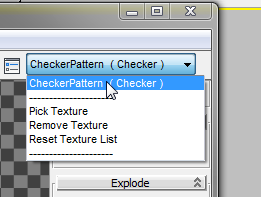
The label already appears, but choosing it from the list activates the pattern, making it visible on the model.
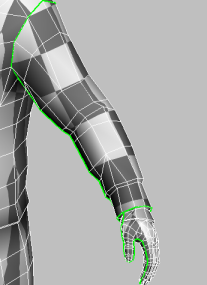
As you can see, the pattern is already pretty regular, thanks to the Quick Peel that Peel Mode applies when you first invoke it. The remainder of this procedure will simply show some of the tools available in Peel Mode.
For example, to make it easier to match the arm or sleeve cluster to an existing texture, you might want to make it more rectangular. But first you'll isolate the cluster.
Sometimes it's a good idea to start the peeling procedure by identifying parts of the cluster whose shape you want to keep, then locking down or "pinning" key vertices. The left side of the cluster is already approximately rectangular, so you can start there.
 (Auto-Pin Moved Vertices) is on, moving a vertex pins it.
(Auto-Pin Moved Vertices) is on, moving a vertex pins it.
If you only create one pin, the other pin will still be invisible and chosen automatically. For this reason, it's a good idea to pin any vertices that you want to hold still first, and then move any vertices that you want to reposition.
 (Pin Selected).
(Pin Selected).
To see this, play the following video:
Note the change in size in the cluster after pinning the two vertices. Because Peel Mode is still in effect, the pinned vertices exerts a change in the tension of the cluster resulting in the size change.
To see this, play the following video:
As you drag, all the other vertices move as well; Peel Mode does this to maintain the overall topology.
Notice that, the more pinned vertices there are near the vertex you're moving, the greater the amount of local control you have. Also, remember that you can always move a pinned vertex directly.
Sometimes while you're peeling you might want to subdivide a cluster partially, such as a head texture from the back of the neck to the crown of a head. We'll simulate that in the next couple of steps.
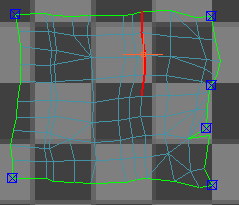
 (Break).
(Break).
The edges separate, pulled apart by Peel Mode's retensioning effect.
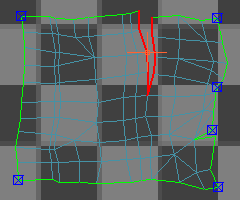
 (Reset Peel). This breaks off the selection as a cluster, applies a Quick Peel, and normalizes the cluster.
(Reset Peel). This breaks off the selection as a cluster, applies a Quick Peel, and normalizes the cluster. 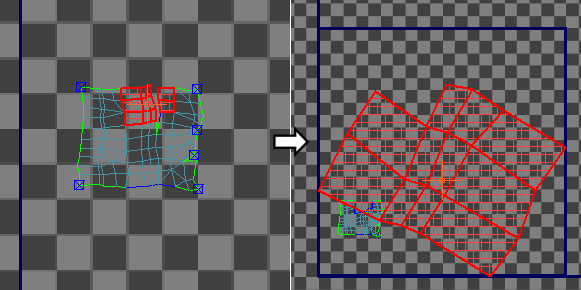
 (Unpin Selected). For other pin-related tools, see Pins group.
(Unpin Selected). For other pin-related tools, see Pins group.
After you apply the Unwrap UVW modifier, its interface appears on the Modify panel, comprising the modifier stack plus several rollouts:
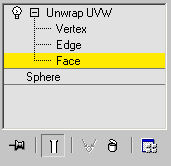
Normally, when you apply Unwrap UVW to an object, the modifier stack provides access to texture coordinates at the Vertex, Edge, and Face (Polygon) sub-object levels. The Vertex and Edge sub-object levels are useful for making UVW vertex and edge selections in the viewports, where texture mapping on the object surface is more readily visible, and the Edge level is also useful for setting up edge selections that you can later convert to seams for use with the Pelt and Peel tools.
If you apply Unwrap UVW to an active face or polygon selection of an Editable/Edit Mesh/Poly object, or to an active patch selection of an Editable/Edit Patch object, only that selection is available for editing with the modifier. If you then change the face or polygon selection in the object, the modifier updates the inherited selection and, again, makes only those faces or polygons available for editing.
When you first apply the Unwrap UVW modifier to an object, no sub-object level is active (even though one of the sub-object buttons on the Selection rollout is always highlighted). You can access a sub-object level from the modifier stack or Selection rollout, or you can just open the Edit UVWs dialog, which activates the Vertex sub-object level, unless a different level is already active. While the editor is open, the sub-object level is synchronized among the modifier stack, the Selection rollout (see following) and the Sub-object Selection toolbar on the Edit UVWs dialog. When you activate a sub-object level in one, it's also activated in the others. Similarly, selecting sub-objects in a viewport selects them in the editor and vice-versa.
When you close the editor, the current sub-object level remains active. You can exit this level in the modifier stack display by clicking the modifier name or the highlighted level.
This rollout contains tools for selecting texture coordinates for manipulating with other tools in the Unwrap UVW modifier.
 (Grow: XY Selection) tool automatically selects sub-objects connected to the current selection. Such tools work in object
(XY) space, as opposed to the comparable tools on the Edit UVWs dialog, which work in texture (UV) space.
(Grow: XY Selection) tool automatically selects sub-objects connected to the current selection. Such tools work in object
(XY) space, as opposed to the comparable tools on the Edit UVWs dialog, which work in texture (UV) space.
For example, say you have a character mesh whose geometry is a single element, but whose texture coordinates are separated into different clusters (head, hands, etc.), for mapping purposes, in the editor. If you go to the Polygon sub-object level of the modifier on the command panel, select a polygon in the viewport, and click the Grow button repeatedly, eventually you'll select the entire model. But if you do the same in the editor, starting with one selected polygon, the most you can ever select with the Grow tool is the cluster to which that sub-object belongs, such as the head.
The following video shows a sphere with Unwrap UVW applied, which was then used to flatten the mapping, resulting in several UVW clusters. First, a few vertices are selected in one cluster in the viewport and the Grow: XY Selection is clicked repeatedly, growing the vertex selection beyond the cluster. Then the vertices are deselected, and a vertex is selected in the cluster in the editor. This time, clicking the Grow button in the editor repeatedly again grows the selection, but not beyond the cluster.
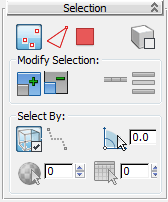
 Vertex/
Vertex/ Edge/
Edge/ Polygon
Polygon Select by Element XY Toggle
Select by Element XY Toggle Ignore Backfacing
Ignore Backfacing Point-to-Point Edge Selection
Point-to-Point Edge SelectionTo exit from making the current selection, right-click once. At that point, the tool remains active so you can start a new selection elsewhere on the object. To exit the tool completely, right-click a second time.
 Select by Planar Angle
Select by Planar AngleWhen active, you can select contiguous coplanar polygons with one click. Turn this on and use the numeric setting to specify the threshold angle value that determines which polygons are coplanar. Then click a polygon to select it and all contiguous polygons whose angles are less than the threshold value.
Select By Planar Angle is available only at the Polygon sub-object level.
 Select by Material ID: XY
Select by Material ID: XYEnables face selection by material ID. Specify the material ID to select, and then click Select By Material ID.
Select By Material ID is available only at the Polygon sub-object level.
 Select by Smoothing Group: XY
Select by Smoothing Group: XYEnables face selection by smoothing group. Specify the smoothing group to select, and then click Select by Smoothing Group.
Select by Smoothing Group is available only at the Polygon sub-object level.
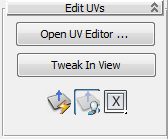
Opens the Edit UVWs dialog.
If the Edit UVWs dialog is open, it updates in real time. Applies at the modifier level and all sub-object levels.
 Quick Planar Map
Quick Planar Map Display Quick Planar Map
Display Quick Planar Map  Averaged Normals
Averaged Normals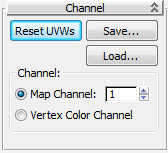
Restores the UVW coordinates to their previous state on the modifier stack; that is, the coordinates inherited from the stack by the Unwrap modifier.
Clicking this is almost the same as removing and reapplying the modifier, except that a map assigned in the Edit UVWs dialog is not deleted. For example, if you forgot to turn on the Generate Mapping Coordinates check box for an object, and then applied the Unwrap UVW modifier, the modifier would have no UVW coordinates to use and its settings would be wrong. If you then go back in the Stack and turn on Generate Mapping Coordinates, you'd need to click the Reset UVWs button. When you click this button, an alert warns you that you're losing any edits you've made.
Each object can have up to 99 different UVW mapping coordinate channels. The default mapping channel (from the Generate Mapping Coordinates toggle in the object’s creation parameters) is always channel 1. You can specify texture coordinates for any channel by using a different Unwrap UVW or UVW Map modifier for each channel.
Sets the identification number of the texture coordinates controlled by this modifier. This channel value corresponds to the Map Channel value set in a map’s parameters, so that the modifier controls how maps set to the same channel are applied to the object surface. Default=1. Range=1 to 99
Please note the following important points about map channels in the Unwrap UVW modifier:
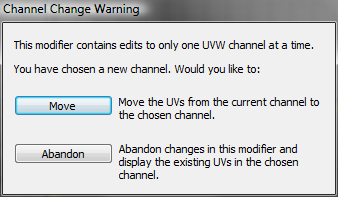
The map channel setting is available in various places in 3ds Max, as follows:
Define the mapping channel as a vertex color channel by choosing this option. Be sure to match any material mapping in the coordinates rollout to be Vertex Color as well, or by using the Assign Vertex Colors utility.
The Peel tools provide an implementation of the LSCM (Least Square Conformal Maps) method of unwrapping texture coordinates, for an easy and inutuitive workflow in flattening complex surfaces. This rollout also provides access to the Pelt method of unwrapping texture coordinates, as well as seam tools for use by the Peel and Pelt tools.
For a brief demonstration of how to use the Peel tools, see this procedure.
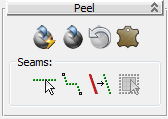
 Quick Peel
Quick PeelQuick Peel is suitable for simple texture-mapping applications, but for better control, use Peel Mode instead (see following).
 Peel Mode
Peel ModeWhile Peel Mode is active, you can create seams with the Edit Seams and Point-to-Point Seams tools (see following), and they automatically "peel" off as you go. Alternatively, in the editor, select some edges and use the Break tool to split the edges and automatically re-peel the cluster.
When Auto-Pin Moved Vertices is on (the default), moving a sub-object in Peel mode pins (locks) all vertices belonging to the sub-object.
 Reset Peel
Reset PeelUse Reset Peel to reconnect map seams on previously mapped geometry, or to quickly break off and Peel a selection.
 Pelt
PeltApplies pelt mapping to selected faces. Clicking this button activates Pelt mode, in which you can adjust the mapping and edit the pelt map.
Use seams to specify cluster outlines for Peel mapping (see preceding) and pelt mapping, as well as to spline mapping (when you use manual seams). Peel/pelt seams are blue, as opposed to the green Map seams that indicate cluster borders.

Peel/Pelt seams (left) are converted to Map seams (right) after peeling.
 Edit Seams
Edit SeamsLets you create pelt/peel seams by selecting edges with the mouse in the viewports. Available at all sub-object levels of the Unwrap UVW modifier.
Using Edit Seams is similar to standard edge selection, with one difference: Designating seams is cumulative by default. That is, you need not hold Ctrl to add edges to the seam collection. With Edit Seams on:
 Point-to-Point Seams
Point-to-Point SeamsIn this mode, after you click a vertex, a rubber-band line extends from the vertex you clicked to the mouse cursor. Click a different vertex to create a seam, and then continue clicking vertices to create a seam from each vertex to the previous one. To start at a different point in this mode, right-click, and then click a different vertex. To stop drawing seams, right-click again, or click the Point-to-Point Seams button again to turn it off.
 Convert Edge Selection To Seams
Convert Edge Selection To Seams Expand Face Selection to Seams
Expand Face Selection to SeamsExpands the current polygon selection to the seam outline. If multiple seam outlines exist and each contains selected polygons, the expansion takes place for only one outline (based on the highest polygon ID); the rest are deselected. Available only at the Polygon sub-object level of the Unwrap UVW modifier.
These controls let you apply and adjust one of four different mapping gizmos to a polygon selection.
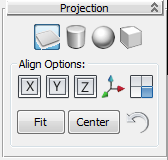
 Planar Map
Planar MapApplies planar mapping to selected polygons.
Make a polygon selection, click Planar Map, adjust the plane gizmo using the transform tools and the Align Options tools, and then click Planar Map again to exit.
 Cylindrical Map
Cylindrical MapApplies cylindrical mapping to selected polygons.
Make a polygon selection, click Cylindrical Map, adjust the cylinder gizmo using the transform tools and the Align Options tools, and then click Cylindrical Map again to exit.
 Spherical Map
Spherical MapApplies spherical mapping to currently selected faces.
Make a polygon selection, click Spherical Map, adjust the sphere gizmo using the transform tools and the Align Options tools, and then click Spherical Map again to exit.
 Box Map
Box MapApplies box mapping to the currently selected faces.
Make a polygon selection, click Box Map, adjust the box gizmo using the transform tools and the Align Options tools, and then click Box Map again to exit.
You can apply regular texture coordinates to irregular objects using these tools.

 Spline Mapping
Spline MappingApplies spline mapping to the currently selected faces. Clicking this button activates Spline mode, in which you can adjust the mapping and edit the spline map.
 Unfold Strip from Loop
Unfold Strip from Loop
1. Original lofted object with default checker pattern applied and edge loop selected
2. After applying Unfold Strip From Loop (closeup view)
3. After selecting parallel edge loops with Ring UV and applying Space Horizontally (closeup view)
Use these settings to specify modifier defaults, including whether and how seams appear.
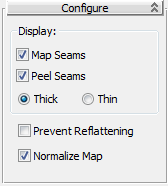
These settings determine whether and how seams appear in the viewports:
When on, mapping cluster boundaries appear in the viewports as green lines. You can change this color by adjusting the Display seams color.
When on, peel and pelt boundaries appear in the viewports as blue lines. For more information, see Peel rollout.
The display thickness setting applies to both pelt seams and map seams:
This option is used mainly for texture baking. When on, the version of the Unwrap UVW modifier automatically applied by Render To Texture, named, by default, Automatic Flatten UVs, does not reflatten the faces. Also, make sure that both Render To Texture and the modifier use the same map channel.
When on, scales the mapping coordinates to fit into the standard coordinate mapping space: 0 to 1. When off, the mapping coordinates are the same size as the object. The map is always tiled once in the 0-1 coordinate space; the part of the map based on its Offset and Tiling values on
For example, if you take a sphere of 25 units that's planar mapped from the top, and then apply Unwrap UVW and turn off Normalize Map, then when you open the editor, the radius of the sphere's mapping coordinates is 25 units. As a result, the texture map is tiled onto the sphere surface many times. With Normalize Map on, both the sphere and the map fit into the 0-1 coordinate space, so they're the same size.
In general, for best results, leave Normalize Map on. One reason to turn it off would be to turn it off is if you want to map several elements of different proportions with a texture of a specific aspect ratio, such as brick, keeping the texture the same size on each object.
The heart of the Edit UVWs dialog is a window that displays texture coordinates depicted as vertices, edges, and polygons, collectively called sub-objects. By default, these match the geometry of the mapped object; by editing the coordinates you change their positions in relationship to the object mesh. This gives you fine-grained control over how your texture maps "fit" your models.